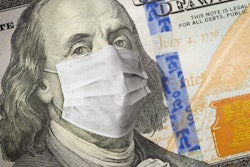
At around this time last year, we were beginning to learn about the various ways medical practices could make use of federal programs to help keep them afloat through the COVID-19 pandemic. No one knew how long it would last.
 Rebecca Farrington.
Rebecca Farrington.As time went on, we followed the changes to those programs, the new programs that became available, and the deadlines for action. Let's review the latest federal legislation and also where each of last year's relief programs stands today, especially the Medicare Payment Sequester that is a developing story.
Medicare Payment Sequester
The 2% sequester of funds from Medicare payments was suspended from May 1 to December 31, 2020. The suspension was later extended through March 31, 2021.
Many healthcare advocacy organizations have urged Congress to further extend the moratorium through the end of the year, and legislation to that effect was passed by both the House of Representatives and the Senate. Once it is finally ratified and signed, the 2% sequester will not be reinstated until 2022.
With Congress in recess until mid-April, we won't know the final answer until it reconvenes. However, since the sequester would apply to claims with dates of service on and after April 1, and those claims would not be paid for at least 14 days after Medicare receives them, there should be no payment delay while waiting for the final result in Congress.
The American Rescue Plan Act
The American Rescue Plan Act (ARPA) was signed March 11 and it includes benefits to employers and their employees facing economic challenges due to the COVID-19 pandemic. It extends the Employee Retention Credit (ERC) through the end of 2021 and changed the rules so that a practice may claim the ERC even if it received a Paycheck Protection Program (PPP) loan, provided the same wages are not used to also calculate the amount of PPP loan forgiveness.
The ERC is now available to employers with fewer than 500 employees that experienced a reduction of at least 20% in gross receipts in 2021 as compared with the same quarter in 2019. Practices receive payment through a credit against their federal Medicare tax (previously it was available against both the Social Security and Medicare taxes) that is refundable if it exceeds the amount of tax otherwise due. The credit is 70% of qualified wages up to $10,000 per employee per quarter, or $7,000 of credit per employee per quarter. This equates to $28,000 of credit per employee in 2021.
The ARPA also extends the "Paid Sick and Family Leave Credit" that was introduced by the Families First Coronavirus Response Act (FFCRA) through September 30, 2021. This program was made optional for employers for 2021.
Beginning April 1, 2021, paid sick leave is reset so that an employee who previously used up their FFCRA sick leave has another 10 days (80 hours) available. Acceptable reasons for using this leave now include time to receive the COVID-19 vaccine, recover from any illness or condition related to the vaccine, or seeking or awaiting the results of a COVID-19 diagnosis or test.
Telemedicine
Relaxation of the rules surrounding the use of telemedicine was one of the first changes that took place early in March 2020. Although there is talk of making some of the changes permanent, the temporary emergency rules are due to expire at the end of the declared Public Health Emergency (PHE).
The PHE is a rolling 90-day declaration that was renewed as of January 21, 2021 through April 20, 2021, and there is no way to know at this point when the cycle of PHE renewals will end although there are indications that it will continue through the end of 2021.
Medicare Accelerated and Advance Payment Program
As we reviewed in a recent article, repayment of advances under Medicare Accelerated and Advance Payment Program (MAAP) will begin for many practices around April 1 or, more precisely, 365 days after the advance was received by the practice.
Provider Relief Fund Grants
Early in April 2020 the U.S. Department of Health and Human Services (HHS) deposited funds directly into the bank accounts of healthcare providers based on a formula related to the practice's Medicare reimbursement in 2019. While the basic statement was made that the funds would not have to be repaid, there were conditions attached and practices had the opportunity to return the funds if they could not meet those conditions. Another round of grant funds became available in October 2020 that required an application and demonstration of financial loss due to the pandemic.
The requirement to report to HHS on the use of grant funds has been in flux. Different levels of reporting and documentation will be required depending on the amount received. A reporting portal was opened as of January 15, 2021 for registration by practices that received grant funds.
There is no deadline for registration, and no timetable is available for reporting. Practices that register on the portal will receive email notification about their reporting requirements. Otherwise, the best source of information for updates on reporting is through the HHS website.
Small Business Administration Loans
The Paycheck Protection Program (PPP) and the Economic Injury Disaster Loan (EIDL) Program provided funding to businesses facing ongoing costs with severely reduced revenue. Both programs allow for forgiveness of all or part of the loan, thereby converting them to a nontaxable grant. Unforgiven loan balances carry favorable repayment terms at low interest rates.
At this point, businesses have had the opportunity to make applications for two rounds of PPP funds and in many cases at least the first round of forgiveness applications have been filed and approved. Some banks have delayed processing of forgiveness applications, using staff to process second-round PPP loans applications.
The opportunity for PPP loan application was set to expire on March 31 but it will be extended until May 31, 2021 pending the president's signature on legislation passed last month. Businesses have up to 10 months from receipt of the funds to file an application for forgiveness.
As there are still unanswered questions, we will continue to monitor and report on all of these programs and any new benefits that are announced.
Rebecca Farrington serves as the chief revenue officer for Healthcare Administrative Partners. She has more than 20 years of experience in healthcare sales and management roles, focusing on hospital-based and physician revenue cycle management.
The comments and observations expressed are those of the author and do not necessarily reflect the opinions of AuntMinnie.com.



















